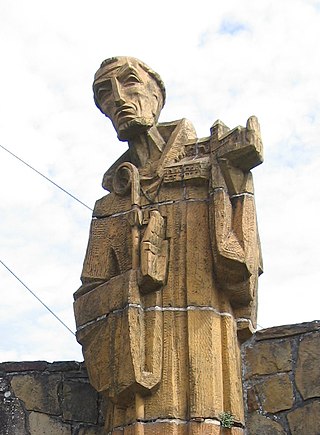
Hugh Faringdon,, earlier known as Hugh Cook, later as Hugh Cook alias Faringdon and Hugh Cook of Faringdon, was a Benedictine monk who presided as the last Abbot of Reading Abbey in the English town of Reading. At the dissolution of the monasteries under King Henry VIII of England, Faringdon was accused of high treason and executed. He was declared a martyr and beatified by the Catholic Church in 1895.

Leonard of Noblac, is a Frankish saint closely associated with the town and abbey of Saint-Léonard-de-Noblat, in Haute-Vienne, in the Limousin region of France. He was converted to Christianity along with the king, at Christmas 496. Leonard became a hermit in the forest of Limousin, where he gathered a number of followers. Leonard or Lienard became one of the most venerated saints of the late Middle Ages. His intercession was credited with miracles for the release of prisoners, women in labour and the diseases of cattle.
Gerald of Mayo is a saint of the Roman Catholic Church and Eastern Orthodox Church.

Fleury Abbey (Floriacum) in Saint-Benoît-sur-Loire, Loiret, France, founded in about 640, is one of the most celebrated Benedictine monasteries of Western Europe, and possesses the relics of St. Benedict of Nursia. Its site on the banks of the Loire has always made it easily accessible from Orléans, a center of culture unbroken since Roman times. In 2010, the abbey had over forty monks led by the abbot Etienne Ricaud.

Bobbio Abbey is a monastery founded by Irish Saint Columbanus in 614, around which later grew up the town of Bobbio, in the province of Piacenza, Emilia-Romagna, Italy. It is dedicated to Saint Columbanus. It was famous as a centre of resistance to Arianism and as one of the greatest libraries in the Middle Ages. The abbey was dissolved under the French administration in 1803, although many of the buildings remain in other uses.

Ligugé Abbey, formally called the Abbey of St. Martin of Ligugé, is a French Benedictine monastery in the Commune of Ligugé, located in the Department of Vienne. Dating to the 4th century, it is the site of one of the earliest monastic foundations in France. The original abbey having been destroyed during the French Revolution, the current monastic community dates from 1853, and belongs to the Solesmes Congregation.

The Diocese of Orléans is a Latin Church diocese of the Catholic Church in France. The diocese currently corresponds to the Départment of Loiret. The current bishop is Jacques André Blaquart, who was appointed in 2010.

The Abbey of Saint Maurice, Agaunum is a Swiss monastery of canons regular in Saint-Maurice, Canton of Valais, which dates from the 6th century. It is situated against a cliff in a section of the road between Geneva and the Simplon Pass. The abbey itself is a territorial abbacy and not part of any diocese. It is best known for its connection to the martyrdom of the Theban Legion, its original practice of perpetual psalmody, and a collection of art and antiquity.

Saint Mesmin is a French saint associated with the Bishopric of Orléans. He was the second abbot of Micy Abbey, founded by his uncle, Saint Euspicius.

Saint Lie of Orléans is a French saint. He is honored in the bishopric of Orléans and his relics are enshrined in the village of Saint-Lyé-la-Forêt in that diocese. His feast day is November 5.

Micy Abbey or the Abbey of Saint-Mesmin, Micy, sometimes referred to as Micy, was a Benedictine abbey near Orléans at the confluence of the Loire and the Loiret, located on the territory of the present commune of Saint-Pryvé-Saint-Mesmin. Since 1939 it has hosted a community of Carmelites.

Saint Gérard founded Brogne Abbey and reformed eighteen others according to the Benedictine Rule.
There is archaeological evidence of insular monasticism as early as the mid 5th century, influenced by establishments in Gaul such as the monastery of Martin of Tours at Marmoutier, the abbey established by Honoratus at Lérins; the abbey of Mont-Saint-Michel; and that of Germanus at Auxerre. Many Irish monks studied at Candida Casa near Whithorn in what is now Galloway in Scotland.
The Congregation of St. Vanne or Congregation of St. Vanne and St. Hydulphe (French: Congrégation de Saint-Vanne et Saint-Hydulphe was a Benedictine reform movement centered in the Duchy of Lorraine. It was formally established in 1604 on the initiative of Didier de La Cour, prior of the Abbey of Saint-Vanne near Verdun, a reformer of the Benedictine Order after the Council of Trent. The Abbey of St. Hydulphe at Moyenmoutier was a secondary centre of the reform.
Saint Vitonus, also called Vanne or Vaune, became a monk as a young man and was later made Bishop of Verdun by King Clovis I.

Molesme Abbey was a well-known Benedictine monastery in Molesme, in Laignes, Côte-d'Or, Burgundy, on the border of the Dioceses of Langres and Troyes.

Aignan or Agnan (358–453), seventh Bishop of Orléans, France, assisted Roman general Flavius Aetius in the defense of the city against Attila the Hun in 451. He is known as Saint Aignan.

December 14 - Eastern Orthodox liturgical calendar - December 16

Paulus of Verdun (576-648) was a bishop of Verdun in the Lorraine region of France from 630 until his death in 647 or 648.

The Church of Saint-Aignan is a collegiate church in the Bourgogne quarter of Orléans on the north bank of the Loire, France. The church is dedicated to Anianus, a 5th-century bishop of Orléans, who, according to legend, persuaded Attila the Hun not to sack the city.















